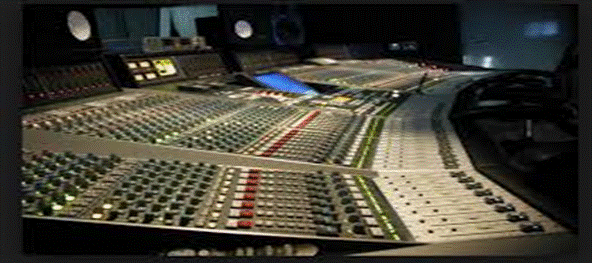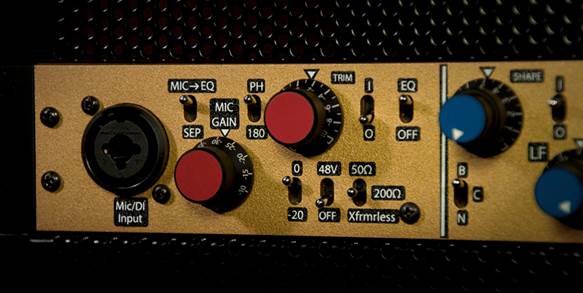If we take a close look at both the Earlybird 2.2 and
Rooster from Thermionic Culture, we see a long list of design and operational
similarities, followed by significant differences that guide each to a
different set of ideal applications.

The earlybird 2.2
Earlybird 2.2
The Earlybird 2.2 is a two-channel, Class A custom Sowter
transformer-loaded tube-based mic amp with three bands of active “lift only”
EQ, high-pass filters and a function switch that allows either mic, padded mic,
line or Pullet inputs. [According to Thermionic Culture, the Pullet is
Thermionic’s two-channel passive EQ that requires significant make-up gain. The
Earlybird’s inputs accommodate with ideal gain and impedance—Ed. The EQ circuit
utilizes “vari-slope” curves for the bass and top lift controls and a broad,
low-Q curve for the mid boost (at either 800 Hz or 2.8 kHz). This EQ is placed
in the feedback portion of the Earlybird’s circuitry and therefore does not
introduce a new gain stage to the circuit; Thermionic reports that it allows EQ
adjustments with- out fear of losing the original tone.
High-pass filters are available at 40, 100 and 800 Hz, with
a -12 dB/octave slope at 40 and 100 Hz plus a broad slope at 800, designed to
interface with the bass lift band in that “resonant filter/response dip before
boost/simultaneous bass boost and cut” method well known to Pultec EQ users.
Although the Earlybird has two different input impedance
settings—300 and 1200 ohms, helpful in fine tuning EQ and transient
response—there’s no DI or instrument input. Gain is at either 36, 44, 52 or 60
dB, with the pad applicable to any gain setting. There are output level trims,
polarity flip and a 48 VDC phantom power switch.
The Rooster
The Rooster will accept mic and line inputs, but also front
panel DIs that bypass the input transformers, sending signal directly to the
unit’s ECC81 double-triode input tube.
The EQ section offers bass lift (varies lope at 60 Hz); bass
cut (five different frequencies at a variety of slopes); a mid/high lift
(either 2.5 or 4 kHz or varies lope at 12 kHz); a mid-cut (700 Hz bell) and a
LPF, which may just be useful when using the Attitude section.
Attitude provides control over the amount and type of
distortion created by a 5725 valve (as found in Thermionic’s popular Culture
Vulture distortion processor). This circuitry starts with a minimal 0.01%
distortion in the 1st position and increases dirt with either Triode (2nd
order) or Pentode (3rd order) as one dials Attitude towards a maximum of six. The
Rooster’s continuously variable out- put via PCF 80 tube and Sowter transformer
has a three-segment LED display.
The ‘Bird Vs. The Rooster
Both the Rooster and Earlybird are overall clean, clear and
full bandwidth, but slightly colored in a subtle way; percussive signals and
bold tones are musically tamed. With sustaining sources, their low-mids seem to
be accentuated and compressed; high end is crisp and present but not irritating
or “on the edge.”
These subtleties are just that subtleties until the user
approaches saturation of the circuits. Hitting the Rooster’s or Earlybird 2.2’s
front end with too much signal create light distortion in a non-obtrusive,
mostly low-mid woofiness that’s only a little ugly, but not Splatty; I dove for
the input gain a moment too late with a jumpy alto.

Audio System
On drum overheads, the Earlybird had enough speed to catch
lively snare, enough fullness to translate toms and a smooth musicality that
mitigated the harshest cymbals. Snare top via SM57 yielded nice, woody mids and
a little extra top end EQ crafted a nice “crack.” Acoustic guitar shined with
the ’Bird, while broad-stroke EQ work is enough to make room/instrument
corrections well within your purview. Vocals of all varieties sound great via
Earlybird, although input gain riding isn’t possible, but at least output is.
Although the Rooster does “clean” just fine, I found it to
be geared towards dirtiness. The Rooster is designed rather similarly to
Thermionic’s flagship distortion processor, the Culture Vulture, and sounds
quite similar, though with far less control variation, less gain available, but
wider bandwidth (much like the Culture Vulture Mastering model).
The Rooster can add serious attitude to DI bass tracks with
creative EQing, filtering and adding its Attitude control. Drum tracks can
receive that edgy triode distortion from Attitude, dangerously adding character
to rock or retro-style productions.
Whole mixes can be goosed up with the Attitude #2 Triode
setting, but I found few mixes benefited by Attitude #3 triode or higher (it
goes to 6). Attitude is likely more useful on subgroups of synths, drums,
vocals, etc. with Triode for subtlety and Pentode for wild fuzziness.

Acoustic guitar
shined with the ’Bird, while broad-stroke EQ work is enough to make
room/instrument corrections well within your purview
Summary
I found myself enjoying these two Thermionic Culture units
with no qualms concerning build quality, design or features. The Earlybird and
the Rooster have enough EQ power to shape and mold sources not in need of
surgery; both are gentle and forgiving with hot inputs, and neither is a big
fuzz pedal (except when crushing the Rooster’s Attitude in Pentode).
These designs and high-class sonics come priced in the
thousands, thus not for the audio production hobbyist. If you place high
importance on nebulous variables like musicality, transient shaping and tunable
saturation, you may find these two cultured Brits to be necessary members of
your audio flock.
|
Early Bird 2.2 Dual-Channel
Tube Preamp Specifications
·
Input Impedance: Mic: 300 or 1200 ohms, switchable, balanced;
Pad: 1.8kΩ; Line: 12.7kΩ’;Pullet: 1.2kΩ
·
Output Impedance: <300Ω
·
Maximum Gain: 62dB
·
Maximum Output Level (MOL): +33dBm (36V RMS)
·
Phase Shift: HF: 16 degrees (4.5%) @ 10kHz; LF: 0 within
audible range
·
Distortion (THD): 1kHz: 0.005%; 100Hz: 0.007%/0.012%
·
Frequency response: +/-0.5 dB: 11Hz to 26 kHz; +/-1 dB: 8Hz to
65kHz
·
Total Noise, un-weighted, 30kHz filter: 114dB below MOL
·
EQ, active controls @ max: Bass: +17dB @ 50 Hz; Mid: +15dB @
800 Hz & 2.5 kHz; Top: +20dB @ 10 kHz
·
Mid frequency selector: 800Hz & 2.5kHz
·
Gain settings (dB): Mic: 36, 44, 52 & 60; Line:−-8, 0, 8
& 16
·
High Pass Filter (Hz): 0, 40, 100, 800
·
Output trim: −18 dB to 0 dB linear reverse attenuator
·
Input and output connectors: 8-XLR, wired balanced ( 2x mic in,
2x line in, 2x pullet in, 2x line out )
·
Fuses: 115V: T1.25A 230V: T0.63A
·
Tube Complement (2ea) — Input: ECC83 (equiv. 7025, 12AX7LPS);
Output: ECC82 (equiv. 6189, 12AU7)
|